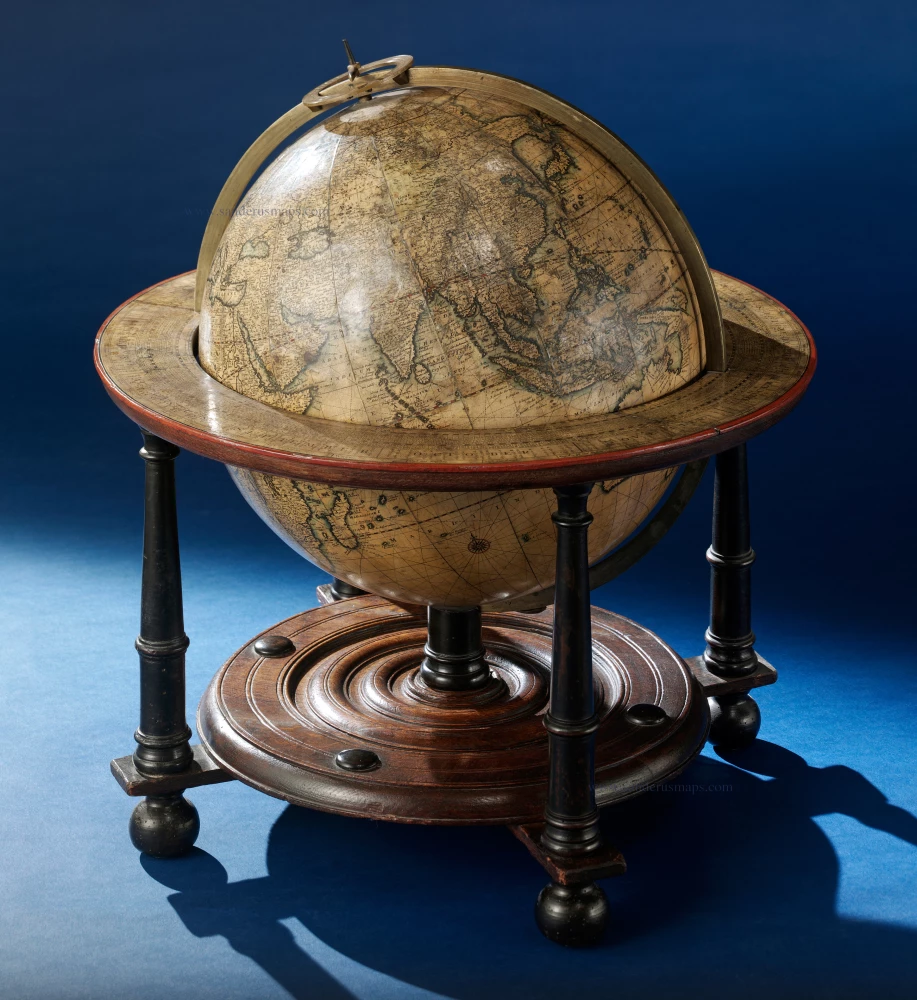TERRESTRIAL GLOBE by Valk G. 1707
The Valk Family
Gerard Valk (Valck) (1652-1726) was Amsterdam's publisher, engraver, art seller, and globemaker. He was trained under Abraham Bloteling, later becoming his assistant. The two moved to London, where Valk worked with various map and print sellers. He married Abraham's sister, Maria Bloteling, in London around 1673; in that city, his son and successor, Leonard, was born in 1675.
Not long after, Bloteling and Valk returned to Amsterdam, where Gerard Valk was registered as a burgher on December 8, 1679.
Around 1680 he began working with the German engraver Petrus Schenk as an engraver, publisher, map and print-sellers. They acquired the plates for the Janssonius Novus Atlas and Sanson's maps. Although they never shared premises, they worked closely together in the publications of editions of these works. Valk and his son Leonard are best known for their globemaking. In addition to globes newly compiled from the latest geographical and astronomical information, the Valk's published theoretical works on astronomy and globes.
In 1710, the family tie between the two partners, Valk and Schenk, became even closer when Gerard's son Leonard Valk (1675-1746) married Maria Schenk (1688-1770), Petrus' daughter.
After the death of Gerard in 1726, the business continued in the hands of his son Leonard and Gerard's widow Maria until she died in 1729, and then by Leonard until he died in 1746.
Cosmotheore, Caelesti nostro Globo, Par; et plane Novus, Hic Terrestris Ut existeret; . . .
Item Number: 21384 Authenticity Guarantee
Category: Antique maps > Curiosities
A handsome 39 cm (15 inches) diameter terrestrial table globe in an original wooden four-legged stand. The globe made up of two sets of eighteen hand-coloured engraved gores and two polar calottes, the equator and prime meridian graduated in degrees, the latter running through the Canary Islands, the ecliptic graduated in days with symbols for the houses of the Zodiac, the oceans with the Tropics and Polar Circles, several wind roses and numerous rhumb lines, the continents with delicate outlines in green, all text in Latin apart from some recent discoveries in Dutch and certain place names such as Lands-end and Burning Hill (in Nova Brittania ) in English, national boundaries shown in dotted outline, with very many details of mountains and rivers, towns, cities and other areas, China with a pictorial representation of the Great Wall, Australia shown joined to New Guinea and lacking eastern coastline, showing detail such as G.F. de Wits Land ontdeckt 1628 and Detecta 1644 in the eastern area, Tasmania labelled Anthom van Diemens Land and lacking northern coastline, New Zealand shown only as a portion of north-western coastline with some places named such as C. Maria van Diemen and bearing the legend Detecta 1642, North America with California shown as an island and bearing details of native inhabitation such as Apaches de Navaio and Apaches de Xila, with no northern or north-western coastline, projected coastline stretching for 75 to eastern Siberia and the Straat de Vries labelled Terra Incognita Terra Esonis the North Pole labelled Polus Terr Boreus and showing little of the surrounding consinents' northern coastlines, the South Pole labelled Polus Terr Meridionalis with no surrounding land masses shown. Engraved brass meridian ring with brass hour dial on top. Some minor repairs. The engraved paper horizon (a part of the engraving repaired and reinstated) graduated in degrees in two sets of two times 180 in opposite directions, in days of the houses of the Zodiac with symbols and names in Latin, a graduated circle of sets of three dots divided in 365 unequal parts, representing the number of days in a normal year, the next circle with the first seven letters of the alphabet repeated to represent the days of the week, the next four circles with numbers 1-28/29/30/31 repeated to represent the days of the month, each moving up slightly to indicate the differing position of the sun over the course of four years, the outer circle representing a leap year, further showing wind directions in Dutch and the names of the months in Latin with numerals and letters corresponding to a circle of the first seven letters of the alphabet repeated, such as 1733 3.1/3 E. corresponding to 1st May, indicating the time of the new moon on the meridian of Amsterdam, the first number indicating the year, the second number indicating the hour in the corresponding day in which the new moon will appear, the letter being the dominical letter of the year.
Size including the wooden stand: 57 x 54cm (22 x 21 inches)
References: Van der Krogt P., Globi Neerlandici, Val III State 1A.
The Valk Family
Gerard Valk (Valck) (1652-1726) was Amsterdam's publisher, engraver, art seller, and globemaker. He was trained under Abraham Bloteling, later becoming his assistant. The two moved to London, where Valk worked with various map and print sellers. He married Abraham's sister, Maria Bloteling, in London around 1673; in that city, his son and successor, Leonard, was born in 1675.
Not long after, Bloteling and Valk returned to Amsterdam, where Gerard Valk was registered as a burgher on December 8, 1679.
Around 1680 he began working with the German engraver Petrus Schenk as an engraver, publisher, map and print-sellers. They acquired the plates for the Janssonius Novus Atlas and Sanson's maps. Although they never shared premises, they worked closely together in the publications of editions of these works. Valk and his son Leonard are best known for their globemaking. In addition to globes newly compiled from the latest geographical and astronomical information, the Valk's published theoretical works on astronomy and globes.
In 1710, the family tie between the two partners, Valk and Schenk, became even closer when Gerard's son Leonard Valk (1675-1746) married Maria Schenk (1688-1770), Petrus' daughter.
After the death of Gerard in 1726, the business continued in the hands of his son Leonard and Gerard's widow Maria until she died in 1729, and then by Leonard until he died in 1746.

